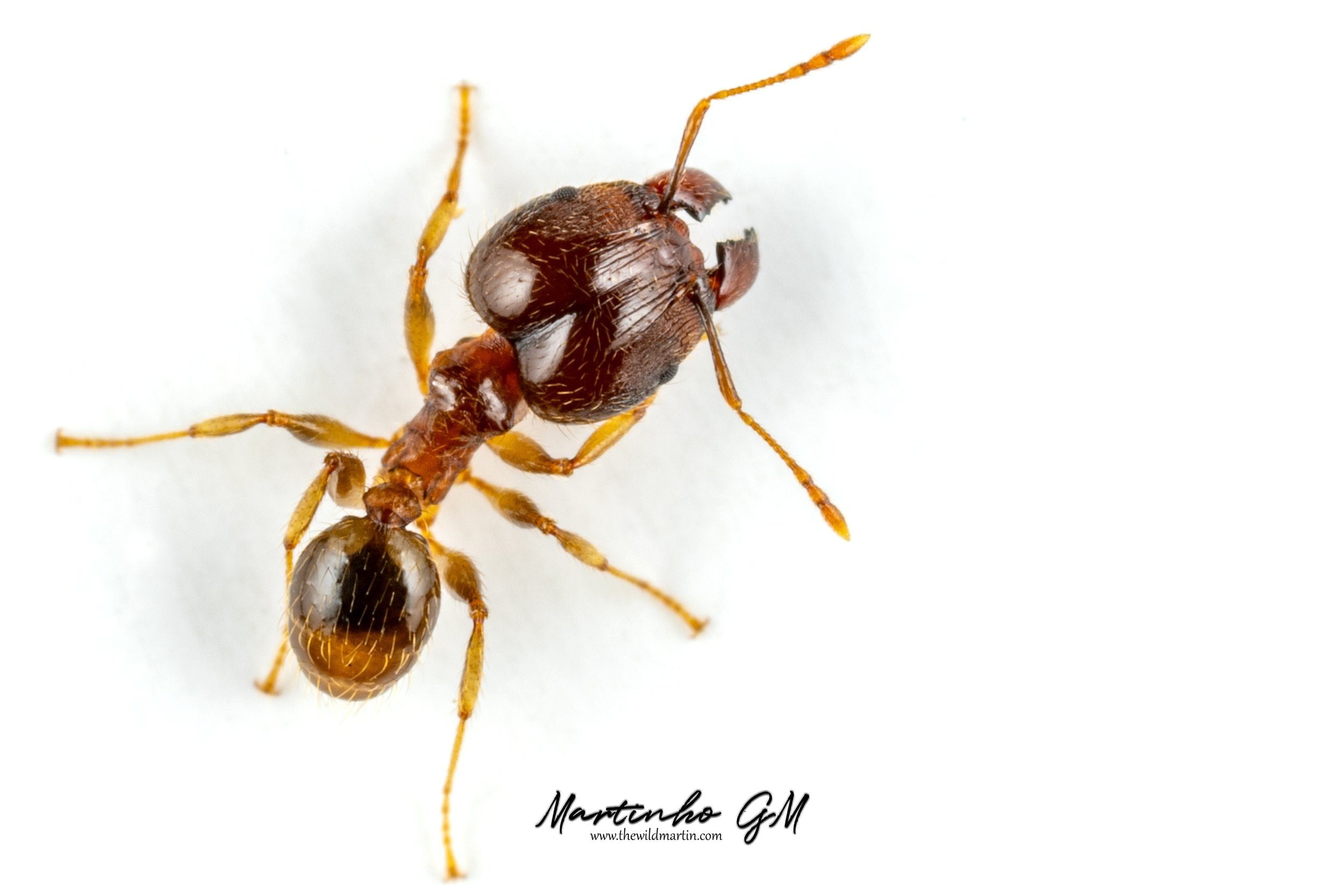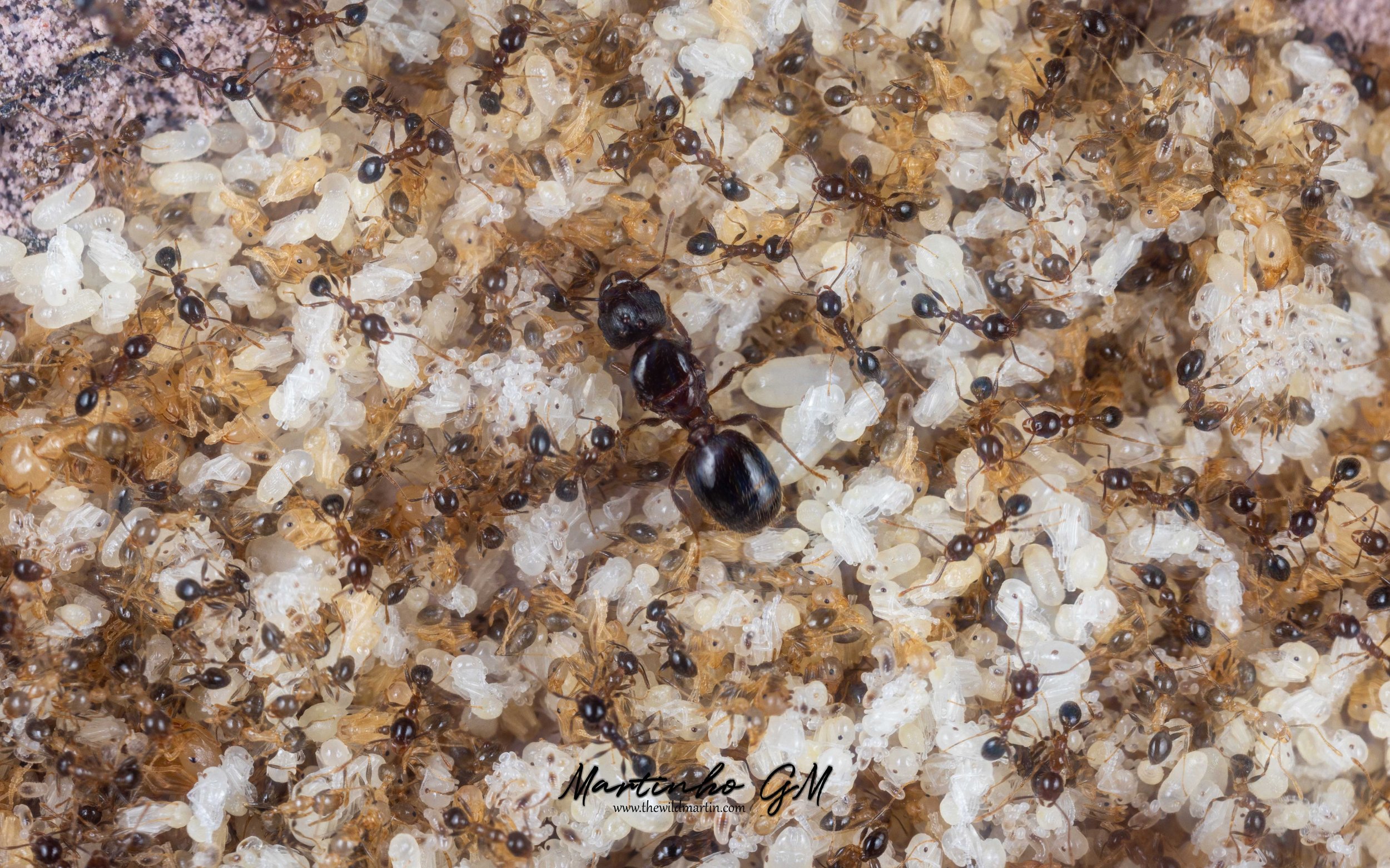Pheidole megacephala Ecology and Care Guide
Pheidole megacephala Queen with a minor worker tending for the brood
INTRODUCTION / SUBFAMILY / GENUS
This species is considered one of the most problematic invasive ant species and has caused devastating environmental problems all over the world, hence it is important to know how to know more about their ecology.
But before we move on, I think I need to address a question:
- “why would one want to know how to keep and care for invasive species?”
The large majority of the invasive ant species, found their way into new lands thanks to our own human activities. There is little can be done now to reverse the situation, but I think it is interesting to show the power of the invasive ants outside their natural environment, how big their colonies can get and how damaging they can be to the local fauna and flora…. be aware of this problem and raise others awareness to it, is the first step that we need to do if we are to prevent similar things from happening in the future.
First described by Fabricius from the former ‘Ile de France’, called Mauritius today, the origins of this species remain unknown.
Pheidole megacephala Queen
They belong to the Myrmicinae subfamily and the Pheidole genus and like all other Pheidole species, Pheidole megacephala shows complete dimorphism (distinct minor and major workers and no intermediates), but we will see more about this in detail on the next paragraphs.
COMMON NAME
Pheidole (read as fidole), comes from Greek and it refers to being thrifty, which is something growing strong and healthy.
Pheidole megacephala is definitely thrifty
As anyone who has ever encountered Pheidole megacephala nests in the wild, or keeping them in captivity, can only be amazed by how vigorous their colonies grow!
In its native habitat this ant species is known as the brown house ant, but for everybody else, Pheidole megacephala is known as the African big headed ant, one of the world's worst invasive ants species.
DISTRIBUTION
AntMaps.org - Pheidole megacephala
Originally suspected to be from the southern parts of Africa, this ant species has spread to the four corners to the world, and is now referred to as a tramp ant species, a species which travels from place to place, inadvertently transported in soil or inside cargo on ships, trains and other human means of transportations.
Tramps ants are associated with human activity, for most part, tramp ants thrive only in disturbed environments and do not penetrate intact natural habitats, but as humans and their disturbance spread, so do the tramp ants.
From the afrotropical countries like South Africa, Angola, Mozambique, etc, all the way into North, Central and South America, Europe, South East Asia and Australia.
CASTES
This ant species belongs to the Myrmicinae subfamily and the Pheidole genus as mentioned before. As usual in all Pheidole species, they have 4 castes, queens, males and a dimorphic caste of workers, the majors also called soldiers and the minors.
Pheidole megacephala castes
And it's their soldier caste that defines their common name, the big headed ants.
DIVISION OF LABOR
Since this species is exclusively dimorphic with absence of intermediate castes, their labor division is very straightforward.
Pheidole megacephala minor worker transporting a larvae
In Pheidole megacephala, minor workers typically do most of the foraging and majors primarily remain inside the nest caring for colony defense, food storage, seed milling.
MORPHOLOGY
Workers are brown often with a darker head and abdomen. Minors measure 2mm while majors measure 3.5mm.
LIFE CYCLE
Regarding the ants life cycle, more specifically the minors life cycle, which is the colonies main life source.
Pheidole megacephala Queen and her first brood
Queens laid from 90 to 300 eggs per month, averaging 6 eggs per queen per day.
Temperature has a substantial effect on the development the brood,
At 22C minors took 78 days to develop, at 24C took 59 days, and at 26C took 38 days to go from egg to adult
Quite a significant variance for 2C or 4C increment in temperature.
On the other hand, colonies required a constant supply of water and a moist environment to thrive.
Pheidole megacephala multiple brood developmental stages
The distribution range and activity of Pheidole megacephala appears to be somewhat limited by susceptibility to desiccation and higher temperatures.
Dry and hot environments will quickly kill any colony.
REPRODUCTIVE STRATEGY
New colonies of Pheidole megacephala are commonly founded through budding, with one or more fertile queens accompanied by a group of workers splitting off from the main colony however, it was found that new colonies may also be founded by single, inseminated queens, also known as haplometrosis.
Pheidole megacephala polygynous colony
On experimental trials, solitary queens began to lay eggs 1-2 days after setup and worker densities reached those found in swarm-created colonies after 200 days.
NEST PREFERENCES
The Big Headed Ants has a clear preference for shady and humid habitats, they can be found nesting in disturbed soils, lawns, flowerbeds, under objects, such as bricks, cement slabs, or flower pots, around trees or water pipes, along the base of structures, and walkways, where displaced soil is usually observed from the action of ants digging below the surface.
Pheidole megacephala Queen in her brood chamber
Well-cared-for lawns may have Big Headed Ants infestations that are less noticeable, except along the edges where lawns meet walkways where piles of soil are often deposited.
Big Headed Ants populations expand into neighboring areas by following along these edges or roadways. Population movements into new areas to establish nests and subsequent displacement of other ant populations can be very rapid.
NEST AND COLONY COMPOSITION
As in several other invasive ant species, colonies are polydomous and polygynous, with nests in large areas often forming supercolonies that aggressively fight other ants or outcompete them by depleting their prey and other resources, but more about this topic down below.
FORAGING AND FEEDING
In the wild, Big Headed Ants are reportedly omnivorous, feeding on sweet liquids such as honeydews, dead insects, and soil invertebrates.
This species has a tendency to alternate between protein and carbohydrate, although a higher preference for protein food is noted. This suggests that a mixture of these two classes of food should be used to ensure a good and thriving colony growth.
Pheidole megacephala minor worker tending for the Queen
Pheidole megacephala is a good predator with an efficient nest mate recruitment that enables the species to dominate any opportunity as foragers will quickly recruit nest mates to a food source. The recruitment mechanism allows this species to organize the defence and rapid depletion of these food sources prior to any contact with competitors.
The first foraging workers are capable of assessing the type and size of the food source and recruit the necessary nest mates accordingly, for example, recruiting the soldiers, which will have the ability to rapidly gather and transport larger loads of liquid food than the minors, and so, gain an advantage on the exploitation.
Even larger and heavier arthropod prey are quickly dissected and brought back to the nest.
Foraging trails and tunnels having numerous entrances, which can be seen along the soil surface, as well as often observed along tree trunks, sometimes climbing into tree canopies. Similar trails may be also seen on the exterior walls of structures as ants climb into artificial voids.
Foraging distances are about 3m away from the tunnels.
DOMINANCE AND AGGRESSION
Another important aspect that gives Pheidole megacephala the upper hand is that they are extremely aggressive toward other ant species. Colonies of Pheidole megacephala are strongly territorial and exclude other dominant territorial ants. Studies show that amongst the top 5 tramp species, big headed ants were the most aggressive species and consistently initiating attacks in all trials.
Pheidole megacephala soldier or major worker
Aggressive behavior coupled with large colony size appear to contribute to the success of Pheidole megacephala in the wild.
TRAMP SPECIES - SUPER COLONY
Like most other species of dominant invasive ants, exotic populations of Pheidole megacephala typically form ‘‘unicolonial supercolonies’’.
Unicolonial ants carry polydomy and polygyny to extremes. Colonies are huge, each being a network of hundreds or thousands of nests, each with multiple queens. There is no worker aggression, and there is free movement among nests on a vast scale. The energy that might have been put into fighting and territoriality flows into the common good, more ants.
Pheidole megacephala extreme growth
The absence of worker aggression over large areas is thought to be important in allowing these ants to attain high densities and ecological dominance. It is thought to be related to the low genetic variation that this species exhibits on its invasive populations.
Recent studies show that encounters between two Pheidole megacephala workers never yield aggression, irrespective of the chemical, genetic or geographical distances between the workers.
The study suggests that other factors are involved in the ecological success of this species: the most important of all - it can live in the vicinity of humans.
The role of human activities is central in the invasion processes, as invasions generally occur through global human movement, as well as from and to human disturbed areas.
Tramp species are known to be able to easily occupy open and disturbed areas, however primary and secondary forests have a lower proportion of these species.
Instead, those habitats contained many endemic species. It has been proved that by maintaining these areas protected and pristine, the endemic vulnerable species have invader-free refuges that allow them to continue to thrive during the peak population densities of invasive ants, and later recover after the invaders’ populations decline.
Pheidole megacephala Queen cooperation
Such an example occurred in Madeira, a portuguese archipelago of the northwest Coast of Africa. Even after about 150 years of residence and mediatic population explosions, Pheidole megacephala failed to achieve widespread distribution and ecological dominance. Climate, vegetation and competition all together proved too much even for the mighty African Big Headed Ant.
Another example, can be found in Australia, where inside the undisturbed areas, the dry/hot weather, serves as a natural barrier, as the thermal limit of the invasive Pheidole megacephala is significantly lower than that of the common Iridomyrmex species.
So even if the weather didn’t finish them off, the endemic rainbow ants would.
Pheidole megacephala foundation stage
CONCLUSION
Hope you have enjoyed reading this article about the “The Big Headed Ants”
Thank you for your time to read it.
For this article you can also check my YouTube video link down below.
Cheers!
Pheidole megacephala, African Big Headed Ants, Growing Super Colony














